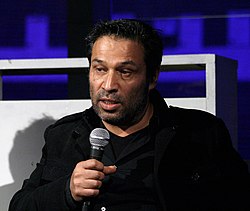Shoja Azari (Persian: شجاع آذری) is an Iranian-born visual artist and filmmaker based in New York City.[1] He is known for his films and multimedia installations.
Shoja Azari | |
|---|---|
شجاع آذری | |
 Azari in 2009 | |
| Born | 18 September 1957[citation needed] Shiraz, Iran |
| Occupations |
|
Early life and education
editAzari was born in Shiraz, Iran.[2] Azari trained as a filmmaker in New York in the 1970s before returning to Iran during the Iranian Revolution in 1979.[3] He then permanently returned to the U.S. In 1997, he first met artist Shirin Neshat when she was assembling a team to create her first video, “Turbulent”.[4] Azari and Neshat became artistic and romantic partners.[4] He is divorced and has one son, Johnny B. Azari, a musician.[4]
Film
editAzari is known for films such as Women Without Men (2009), Windows (2006), and K (2002). These were based on three of Franz Kafka's short stories: "The Married Couple", "In the Penal Colony", and "A Fratricide", respectively.[citation needed] He co-directed with Neshat the film Land of Dreams (2021), which won the Golden Peacock Award at the 52nd International Film Festival of India.[5]
Multimedia installations and art
editAccording to Carol Kino of The New York Times, Azari's "multimedia installations have been increasingly showcased in galleries and museums around the world."[4] His first solo exhibition in New York occurred in 2010 at the Leila Taghinia-Milani Heller Gallery.[4] His video installation work, Idyllic Life (2012), was part of the exhibition In the Fields of Empty Days: The Intersection of Past and Present in Iranian Art (2018) at the Los Angeles County Museum of Art.[6][1]
See also
editReferences
edit- ^ a b "FAKE: Idyllic Life by Shoja Azari - review". The Guardian News. theguardian.com. 9 December 2013. Retrieved 12 June 2014.
- ^ Sanaz, Sanaz Khalaj-Santos (24 January 2011). "Undaunted Art: Interview with Iranian Artist, Shoja Azari". Persianesque Magazine. Retrieved 2 February 2022.
- ^ "Artist Uses YouTube And 19th Century Orientalist Painting To Explore Views of the Middle East". huffingtonpost.com. 21 November 2013. Retrieved 12 June 2014.
- ^ a b c d e Kino, Carol (19 May 2010). "Shoja Azari Puts New Faces on Islamic History". The New York Times. ISSN 0362-4331. Retrieved 16 May 2018.
- ^ Shemin, Joy (11 November 2021). "Three Indian films in IFFI's international competition section". Deccan Herald.
- ^ "Review | Can art help us understand Iran? A new LACMA exhibit misses the mark". Washington Post. ISSN 0190-8286. Retrieved 2 February 2022.
External links
edit- Shoja Azari at the Leila Heller Gallery